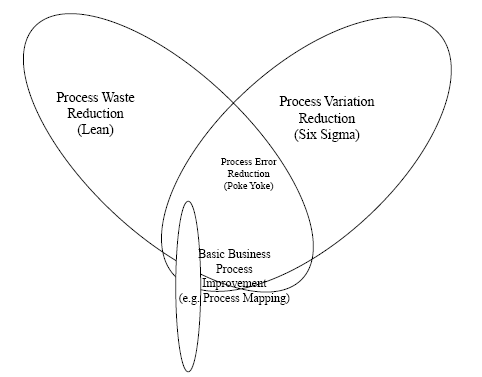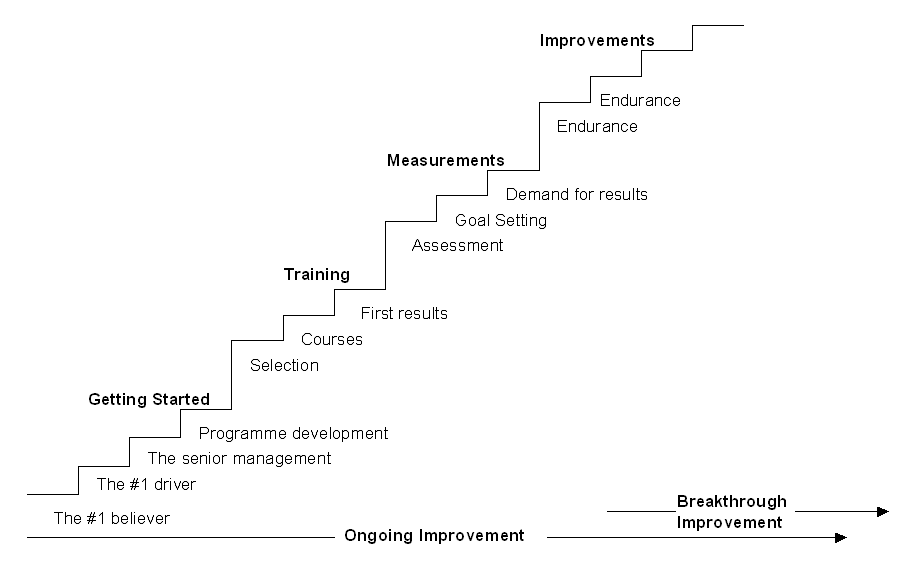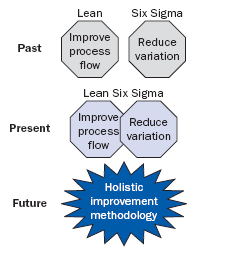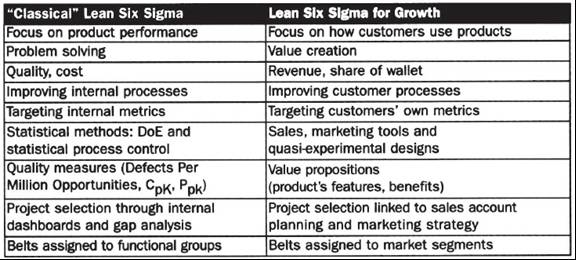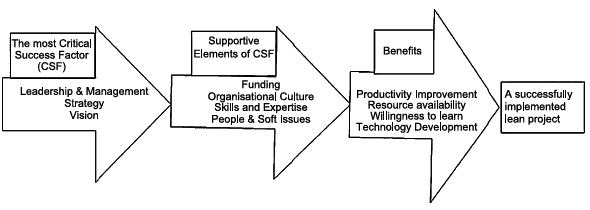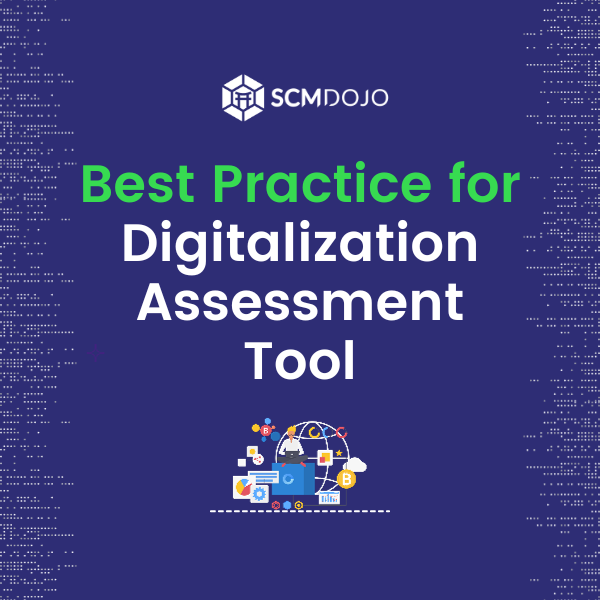In today’s fiercely competitive business landscape, the quest for continuous improvement has become imperative for small and medium-sized enterprises (SMEs) to thrive. Over the years, various methodologies have emerged to address this need, including lean manufacturing, Six Sigma, and the integration of both known as Lean Six Sigma (LSS). In this blog, we’ll delve into the integrated Lean Six Sigma approach, exploring its benefits, deployment models, moreover the implications for SMEs.
Understanding Lean and Six Sigma
Lean and Six Sigma are two powerful methodologies aimed at enhancing organizational efficiency and quality. While Lean focuses on eliminating waste and optimizing processes to achieve seamless workflow, Six Sigma targets reducing variation and improving quality through data-driven analysis and statistical tools.
Figure-a: A holistic model for business process improvement (Source: Bendell, 2006)
Table 1: Comparison of Six Sigma and Lean Management*
|
SIX SIGMA |
LEAN |
|
| Purpose |
Problem-focused/ No defects |
Flow-focused/ Remove waste |
| Origin |
The quality evolution in Japan and Motorola |
The quality evolution in Japan and Toyota |
| Methodology |
Define Measure Analyse Improve Control |
Identify Customer value Identify Value stream Flow Pull Perfection |
|
Goal |
Reduce variation and improve the process |
Remove waste and improve flow |
| Primary Effect | Save Money | Reduce Lead Time |
| Approach | Project Management | Project Management |
| Major Tools | – Statistical Process Control
– MSA – Measurement system assessment – GR&R – DOE – Design of Experiment – FMEA – Failure Mode and Effect Analysis – Root Causes Analysis & Hypothesis Test – Regression Analysis – ANOVA |
– Single Piece flow process – Kanban – Pull Scheduling – Reliable process TPM – Visual Factory – Kaizan – 5 S – Time-Value Diagram – Value-Stream Mapping |
* Adapted from Ehrlich (2002); Stamatis (2002); George (2003); Bendell (2006); Bhuiyan et.al, (2006); Andersson et.al, (2006); Arnheiter and Maleyeff (2005); Nonthaleerak (2005); Kumar (2007); Magnusson et.al, (2003)
Strengths and Weaknesses of Six Sigma and Lean
| SIX SIGMA | LEAN | |
| Strengths | – Six Sigma focuses on improving the process by reducing defects, Moreover, eliminating process variations through a well-structured data-driven methodology.
– Six Sigma creates a link between tactical actions and strategic focus. For example, statistical techniques are used in a systematic way to reduce variation and improve processes, and there is a stronger focus on results, including customer needs. – Six Sigma can design and implement a company-wide and highly structured education and training regimen – No Six Sigma project will be approved unless the team determines the savings generated from it, hence focus on bottom-line savings. – DMAIC methodology links tools and techniques in a sequential manner. |
– Comparatively simple deployment tools.
– Operational improvements (reduction of lead time, increase in productivity, and reduction in work-in-process inventory, etc.). – Administrative improvements (reduction in order processing errors, streamlining of customer service functions so that customers are no longer placed on hold, etc.) – Strategic improvements (reduced costs, etc.). – Lean management incorporates a management decision-making process that bases every decision on its relative impact on the customer |
| Weaknesses | – Potential tendency towards complexity of technique and analysis
– Does not involve everybody. – Does not have a system view (Six Sigma project is often executed in the department of the project members. The project normally leads to an improvement in the department of the project members, but due to the performed change another department can experience deterioration) |
– Lean does not have any statistical tools to control variations in the processes.
– Lean organizations may become very susceptible to the impact of changes. – Reduced flexibility and less ability to react to new conditions and circumstances. – JIT deliveries cause congestion in the supply chain which leads to delays, pollution, shortage of workers, etc. – Lastly, Not applicable to all industries. |
* Adapted from Ehrlich (2002); Stamatis (2002); George (2003); Bendell (2006); Bhuiyan et.al, (2006); Andersson et.al, (2006); Arnheiter and Maleyeff (2005); Nonthaleerak (2005); Kumar (2007); Magnusson et.al, (2003)
Read more on Top 15 Lean Six Sigma Books to Level Up Your Continuous Improvement Efforts & Strategy on our website SCMDOJO!
Integrating Lean Management and Six Sigma
Table 2: The Frame of the Lean Leap (source: Womack and Jones, 2003)
| Phase | Specific Steps | Time Frame |
| Get Started |
|
First six months |
| Create a new Organisation |
|
Six months through year two |
| Install business systems |
|
Years three and four |
| Complete the transformation |
|
By the end of year five |
Figure-b: The 12-step deployment model for Six Sigma (Source: Magnusson et.al, 2003)
The Strengths of Integration
Integrating Lean Six Sigma offers numerous advantages for small and medium-sized enterprises (SMEs) while enabling them to enhance efficiency, quality, and competitiveness. Below are the key strengths of integrating these methodologies tailored specifically for SMEs:
1. Holistic Process Optimization
When combining Lean’s focus on waste reduction with Six Sigma’s emphasis on variation reduction, SMEs can achieve comprehensive process optimization. This holistic approach ensures that all aspects of operations are streamlined and optimized, leading to improved productivity and resource utilization.
2. Proactive Problem Identification
Integrating Lean Six Sigma enables SMEs to proactively identify and address potential problems before they escalate. By utilizing tools such as value stream mapping and statistical analysis, SMEs can anticipate challenges and implement preventive measures, minimizing disruptions and improving overall performance.
3. Enhanced Quality and Customer Satisfaction
Lean Six Sigma methodologies prioritize quality improvement while ensuring that SMEs deliver products and services that meet or exceed customer expectations. Moreover, by reducing defects and errors, SMEs can enhance customer satisfaction, build loyalty, and gain a competitive edge in the market.
Moreover, by implementing Lean Six Sigma practices, SMEs can establish a robust quality management system that consistently delivers high-quality products and services to their customers.
4. Efficient Resource Utilization
Lean Six Sigma enables SMEs to optimize resource utilization by eliminating waste and inefficiencies. SMEs can streamline processes through continuous improvement initiatives, moreover, reduce costs, and maximize the value of available resources, leading to improved profitability and sustainability.
Furthermore, Lean Six Sigma empowers SMEs to identify and eliminate unnecessary expenses, thereby freeing up resources that can be redirected toward strategic initiatives and growth opportunities.
5. Empowered Workforce
Integrating Lean Six Sigma fosters a culture of continuous improvement within SMEs, empowering employees to actively contribute to organizational success. When involving employees in problem-solving and decision-making processes, SMEs can tap into their knowledge and expertise, driving innovation and engagement across the organization.
By investing in employee development and fostering a culture of collaboration, SMEs can harness the full potential of their workforce to achieve their strategic objectives. Additionally, an empowered workforce is more motivated and engaged, leading to higher levels of productivity and job satisfaction within the organization.
6. Scalability and Adaptability
Lean Six Sigma methodologies can be tailored to suit the unique needs and challenges of SMEs, making them scalable and adaptable to changing business environments. Whether facing growth opportunities or market fluctuations, SMEs can rely on Lean Six Sigma principles to navigate challenges and seize opportunities for expansion and development.
7. Competitive Advantage
By embracing Lean Six Sigma, SMEs can differentiate themselves in the marketplace by demonstrating a commitment to excellence, quality, and continuous improvement. While, this can enhance their reputation, attract customers, and position them as industry leaders, it can also provide a sustainable competitive advantage in today’s dynamic business landscape.
In summary, the integration of Lean Six Sigma offers SMEs a powerful framework for achieving operational excellence, driving growth, and staying ahead of the competition. By leveraging the strengths of both methodologies, SMEs can optimize processes, enhance quality, and deliver value to customers, ultimately positioning themselves for long-term success and sustainability.
Past, Present, and Future of Lean Six Sigma:
Snee and Hoerl (2007) recommended many companies have focused on lean or Six Sigma, but rarely on both, as their improvement approach. However, today some businesses are working to integrate the two under a common name such as lean Six Sigma as shown in Figure-c. As a future strategy, Lean Six Sigma and other approaches can be brought together as a part of a holistic improvement method to achieve maximum performance improvement.
Figure-c: Evolution of Lean Six Sigma (source: Snee, R.D. and. Hoerl, R.W., 2007)
According to Abramowich (2008) leading Six Sigma companies no longer just talk about quality or cost reduction. Now it is all about customer value creation and revenue generation (see Figure-d). Furthermore, Customers nowadays are more solutions-focused, not just stand-alone products. Lean Six Sigma provides the methodology to make it happen.
Figure-d: A New Lean Six Sigma (source: Abramowich, 2008)
Deployment Models
Various deployment models have been proposed to guide organizations in implementing Lean Six Sigma effectively. For instance, Bendell (2006) and Snee and Hoerl (2007) emphasize the importance of senior leadership commitment, dedicated change agents, comprehensive training, and cultural transformation. These models outline step-by-step processes, such as value stream mapping and policy deployment, to facilitate the integration of Lean and Six Sigma methodologies.
However, existing literature lacks specific guidance tailored to the unique context of SMEs, highlighting a research gap in this area. While larger corporations may have the resources and infrastructure to implement standard Lean Six Sigma models, SMEs often face constraints such as limited budgets, fewer personnel, and different organizational structures. Therefore, adapting these models to suit the specific needs and constraints of SMEs is crucial for successful implementation.
Read more on Supplier Development Programme in Lean Six Sigma and SME Context on our website SCMDOJO!
Challenges and Considerations for SMEs
While Lean Six Sigma offers significant benefits, SMEs may encounter challenges in its implementation. Limited resources, lack of expertise, and resistance to change are common hurdles faced by SMEs. Additionally, the traditional Lean Six Sigma deployment models designed for large corporations may not fully address the realities of SMEs.
To overcome these challenges, SMEs must adopt a tailored approach to Lean Six Sigma implementation. This includes:
Resource Optimization:
SMEs must prioritize the allocation of resources to areas with the highest potential for improvement. This may involve leveraging existing talent, investing in targeted training programs, and utilizing cost-effective tools and technologies.
Cultural Transformation:
Creating a culture of continuous improvement is essential for the success of Lean Six Sigma initiatives. Additionally, SMEs should foster open communication, collaboration, and empowerment among employees to drive positive change.
Flexibility and Adaptability:
Unlike larger corporations, SMEs may need to be more flexible and adaptable in their approach to Lean Six Sigma. This may involve modifying standard deployment models, experimenting with different tools and techniques, and embracing a mindset of experimentation and learning.
Critical Success Factors: The Key to Lean and Six Sigma Success in SMEs
In the world of small and medium-sized enterprises (SMEs), implementing lean manufacturing and Six Sigma methodologies can be a transformative journey. But what separates successful ventures from those that falter? Let’s explore the critical success factors (CSFs) uncovered through research in the UK.
Unlocking Lean Success
A study by Achanga et. al (2006) delved into the experiences of ten SMEs in the UK that embraced lean manufacturing. Through interviews and observations, they uncovered the key ingredients for success. Among them, leadership, management, finance, organizational culture, and skills & expertise stood out as crucial factors. Moreover, the study emphasized the pivotal role of strong leadership and management support, which serve as the foundation for implementing any new idea within an organization.
Figure-f: Elements of Critical Factors for a Successful Lean Implementation (source: Achanga et. al, 2006)
Paving the Way with Six Sigma
In another study conducted by Kumar (2007), the focus shifted to Six Sigma implementation in a UK manufacturing SME. Through surveys and interviews, Kumar identified critical success factors that propelled organizations forward. These include:
- Management involvement
- Linking Six Sigma to customer needs
- Fostering cultural change
- Investing in education and training
- Having a clear vision and plan supported by the CEO
Navigating the Journey
While both lean manufacturing and Six Sigma offer tremendous benefits, their successful implementation in SMEs hinges on addressing these critical success factors. SMEs can overcome challenges and unlock the full potential of these methodologies by prioritizing leadership, and fostering a supportive organizational culture. Moreover, investing in employee training can foster the same results.
In essence, understanding and embracing these critical success factors pave the way for SMEs to thrive in today’s competitive landscape. Furthermore, by leveraging the power of lean manufacturing and Six Sigma, SMEs can drive continuous improvement, enhance efficiency, and achieve sustainable growth.
So, whether you’re embarking on a lean journey or embracing Six Sigma principles, remember to focus on what truly matters – leadership, commitment, and a culture of continuous improvement. In essence, success is within reach for SMEs willing to embrace change and innovation with the right approach.
Closing the Research Gap
Further research is needed to develop tailored deployment models and guidelines specifically designed for SMEs. These models should consider factors such as resource constraints, organizational structure, and cultural dynamics unique to SMEs. Additionally, empirical studies focusing on Lean Six Sigma implementation in SMEs can provide valuable insights and best practices for overcoming challenges and maximizing benefits.
Conclusion
In conclusion, the integration of Lean and Six Sigma offers SMEs a powerful framework for continuous improvement. By leveraging the strengths of both methodologies, SMEs can streamline processes, enhance quality, and drive sustainable growth. However, successful implementation requires tailored deployment models, strong leadership commitment, and a culture of continuous improvement. As SMEs navigate the complexities of today’s business environment, embracing Lean Six Sigma can position them for long-term success and competitiveness.
Read more on 10 Amazing Online Lean Six Sigma Courses for Supply Chain Professionals on our website SCMDOJO!
References:
Abramowich, E. (2008), “Lean Six Sigma New Look”, ASQ Six Sigma Forum Magazine, Vol. 7 No.2, pp. 38-39
Achanga, P., Shehab, E., Roy, R. and Nelder, G. (2006), “Critical success factors for lean implementation within SMEs”, Journal of Manufacturing Technology Management” Vol. 17 No. 4, pp. 460-471.
Andersson, R, Eriksson, H. and Ha°kan Torstensson, H (2006), “Similarities and differences between TQM, Six Sigma and lean”, The TQM Magazine, Vol. 18 No. 3, 2006, pp. 282-296.
Arnheiter, E. D. and Maleyeff, J. (2005), “ The integration of lean management and Six Sigma”, The TQM Magazine, Vol. 17 No. 1, pp. 5-18
Bendell, R. (2006). [Title of Bendell’s paper]. Journal Name, Volume(Issue), Page Numbers.
Bhuiyan, N. and Baghel, A. (2005), “An overview of continuous improvement: from the past to the present”, Management Decision, Vol. 43 No. 5, pp. 761-771
George, M.L. (2002), Lean Six Sigma: Combining Six Sigma with Lean Speed, McGraw-Hill, New York, NY.
Kumar, M. (2007), “Critical success factors and hurdles to Six Sigma implementation: the case of a UK manufacturing SME”, International Journal of Six Sigma and Competitive Advantage, Vol.3 No.4, pp. 333-351
Magnusson. K; Kroslid. D and Bergman. B. (2003), Six Sigma-The Pragmatic Approach (2nd Edition). Studentlitteratur, Lund.
Nonthaleerak, P. (2005), Strengthening Six Sigma for service implementations, Thesis (Ph.D.)–Lancaster University, Lancaster.
Snee, R. D., & Hoerl, R. W. (2007). [Title of Snee & Hoerl’s paper]. Journal Name, Volume(Issue), Page Numbers.



